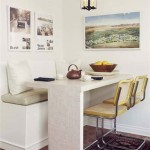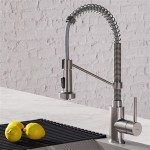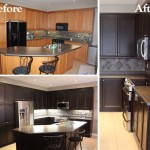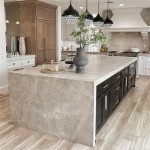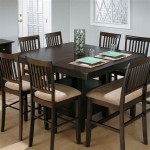Designing a Kitchen with Dark Cabinets and Dark Floors: A Comprehensive Guide
The combination of dark cabinets and dark floors in a kitchen creates a bold and dramatic statement. This design choice, while visually striking, requires careful consideration to ensure the space remains inviting and functional rather than feeling cramped or oppressive. Effectively utilizing light, texture, and complementary colors is crucial to achieving a balanced and aesthetically pleasing kitchen when embracing this darker palette.
This article will explore the key aspects of designing a kitchen featuring dark cabinets and dark floors, covering important considerations such as lighting, material choices, coordinating elements, and strategies for maximizing the perceived space. The goal is to provide a comprehensive understanding of how to successfully implement this sophisticated design aesthetic.
Understanding the Appeal and Challenges
The appeal of dark cabinets and dark floors stems from their ability to evoke a sense of luxury, sophistication, and grounded elegance. Dark tones inherently create a feeling of depth and richness, transforming a standard kitchen into a space with more visual impact. This design choice often aligns with modern, contemporary, and transitional styles, where clean lines and strong contrasts are valued.
However, the inherent challenges associated with using dark colors extensively in a kitchen are undeniable. Dark surfaces absorb light rather than reflect it, which can lead to a dimly lit space, particularly if natural light is limited. Furthermore, dark colors can visually shrink a room, making it feel smaller than it actually is. Dust, crumbs, and imperfections are also often more noticeable on dark surfaces, requiring more diligent cleaning and maintenance.
To mitigate these potential drawbacks, careful planning and execution are essential. This includes strategic lighting, choosing the right materials, and incorporating lighter elements to create balance and visual interest.
Strategic Lighting Solutions
Proper lighting is paramount in a kitchen with dark cabinets and dark floors. A multi-layered approach to lighting is recommended, incorporating ambient, task, and accent lighting to ensure adequate illumination and create a visually appealing atmosphere. Ambient lighting provides overall illumination for the entire space, while task lighting focuses on specific work areas like countertops and the sink. Accent lighting highlights particular features or adds visual interest.
Recessed lighting is a popular choice for ambient lighting, providing a clean and unobtrusive source of illumination. Consider using LED bulbs with a warm color temperature to create a welcoming and inviting atmosphere. Under-cabinet lighting is essential for task lighting, illuminating the countertops directly below the cabinets and reducing shadows. Light bars or individual LED puck lights can be used for this purpose.
Pendant lights over the island or peninsula serve both functional and aesthetic purposes, providing task lighting for food preparation and adding a decorative element to the space. Choose pendant lights with open shades or clear glass to allow more light to pass through. Consider also incorporating accent lighting, such as spotlights to highlight artwork, decorative objects, or architectural details.
Natural light should be maximized whenever possible. If the kitchen has windows, ensure they are unobstructed to allow natural light to flood the space. Consider adding a skylight to bring in even more natural light, particularly in kitchens with limited window space. Light-colored window treatments, such as sheer curtains or blinds, can also help to diffuse natural light and prevent glare.
Material Choices and Textural Contrast
The choice of materials plays a significant role in the overall success of a kitchen with dark cabinets and dark floors. Opting for materials with varying textures and sheens can help to break up the monotony of the dark palette and create visual interest. Consider the following material options:
Cabinetry: Dark wood cabinets, such as walnut, espresso-stained maple, or painted black cabinets, are common choices. The finish can be matte, satin, or semi-gloss, depending on the desired aesthetic. Matte finishes tend to absorb more light, while semi-gloss finishes reflect more light. Consider incorporating glass-fronted cabinets or open shelving to break up the expanse of dark cabinetry and display lighter-colored items.
Flooring: Dark hardwood, slate, or dark-colored tiles are popular flooring options. The texture of the flooring can add visual interest. For example, hardwood with a pronounced grain pattern or slate with a natural cleft surface can create a more dynamic look. Consider using a matte finish on the flooring to prevent excessive glare.
Countertops: Light-colored countertops are essential for creating contrast and brightening up the space. White or light gray quartz, granite, or marble are excellent choices. The veining patterns in natural stone can add visual interest and prevent the countertops from appearing too stark. Butcher block countertops are another option, providing a warm and natural contrast to the dark cabinetry and flooring.
Backsplash: The backsplash provides another opportunity to introduce lighter colors and textures. White subway tiles, glass tiles, or mosaic tiles are popular choices. Consider using a contrasting grout color to highlight the tile pattern. A mirrored backsplash can also help to reflect light and create the illusion of more space.
Hardware and Fixtures: Choose hardware and fixtures that complement the overall design aesthetic. Brushed nickel, stainless steel, or brass hardware can add a touch of elegance and sophistication. Light-colored or metallic fixtures can also help to brighten up the space.
Coordinating Elements and Color Palette
When designing a kitchen with dark cabinets and dark floors, it is essential to carefully coordinate the other elements in the space, including wall color, appliances, and accessories. The color palette should be carefully considered to ensure a cohesive and balanced look. The key is to avoid overwhelming the space with too many dark elements.
Wall Color: Light and neutral wall colors are generally recommended to balance the darkness of the cabinets and floors. White, off-white, light gray, or beige are excellent choices. These colors reflect light and create a sense of spaciousness. Avoid using dark or saturated colors on the walls, as this can make the kitchen feel enclosed and claustrophobic.
Appliances: Stainless steel appliances are a popular choice for kitchens with dark cabinets and dark floors, as they provide a sleek and modern look. White appliances can also work well, creating a clean and bright contrast. Avoid using black appliances, as they can blend in with the dark cabinetry and flooring and make the kitchen feel even darker. Panel-ready appliances that match the cabinetry can offer a seamless, integrated appearance.
Accessories: Accessories can add pops of color and personality to the kitchen. Use bright-colored dishware, artwork, or textiles to create visual interest and prevent the space from feeling too monotonous. Fresh flowers or greenery can also add a touch of life and vibrancy to the kitchen. Consider adding metallic accents, such as copper or gold, to add warmth and luxury to the space.
Accents: Strategic use of light-colored or highly reflective accents can significantly enhance the overall aesthetic. This includes items like light-colored countertops, backsplashes, and strategically placed mirrors. Metallic accents, such as stainless steel appliances, brushed nickel hardware, or copper cookware, can reflect light and add visual interest.
Maximizing Perceived Space
Since dark colors can visually shrink a room, it's crucial to employ strategies that maximize the perceived space in a kitchen with dark cabinets and dark floors. This involves optimizing layout, utilizing reflective surfaces, and creating a sense of openness. These measures will help to create a kitchen that feels larger and more inviting.
Layout Optimization: An open floor plan can significantly enhance the feeling of spaciousness. If possible, consider removing walls or creating larger openings to connect the kitchen to adjacent living areas. A well-designed island can also provide additional counter space and storage without making the kitchen feel cramped.
Reflective Surfaces: Incorporating reflective surfaces can help to bounce light around the room and create the illusion of more space. Polished countertops, mirrored backsplashes, and glossy cabinet finishes can all contribute to this effect. Using mirrored panels on the sides of cabinets or on the island can also visually expand the space.
Vertical Emphasis: Drawing the eye upward can make the kitchen feel taller and more spacious. This can be achieved by using floor-to-ceiling cabinetry, vertical tile patterns on the backsplash, or tall decorative objects. Pendant lights with long cords can also draw the eye upward and create a sense of height.
Minimalism: Clutter can make any space feel smaller and more cramped. Keep countertops clear and organized, and store items neatly in cabinets and drawers. Avoid displaying too many small objects, as this can create a cluttered and overwhelming look. A minimalist approach to design can help to create a clean and uncluttered space that feels larger and more open.
By implementing these strategies, homeowners can successfully design a kitchen with dark cabinets and dark floors that is both visually stunning and functionally efficient. Careful consideration of lighting, material choices, coordinating elements, and space-maximizing techniques is essential for creating a kitchen that feels inviting, balanced, and aesthetically pleasing.

17 Flooring Options For Dark Kitchen Cabinets

11 Ideas For Dark Kitchen Cabinets Paintzen
:max_bytes(150000):strip_icc()/1306-Clifford-Ave.-Ryann-Ford-Kitchen-5c854cea46e0fb00014319bd.jpg?strip=all)
24 Kitchens With Beautiful Black Cabinets

7 Best Dark Cabinets And Floors Ideas Kitchen Remodel Design Inspirations

Premium Photo Kitchen In A New Luxury Home Hardwood Floors Dark Cabinets

Can I Have Light Kitchen Cabinets With Dark Floors

Flooring Ideas For Dark Kitchen Cabinets Wren Kitchens

Will A Dark Color Scheme Work For Your Kitchen

Blog Archive How To Choose Dark Kitchen Cabinets

Flooring Ideas For Dark Kitchen Cabinets Wren Kitchens
See Also

